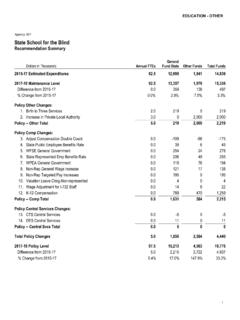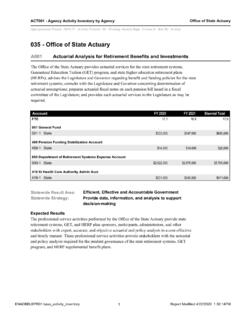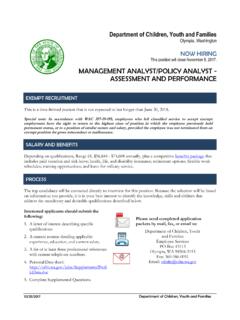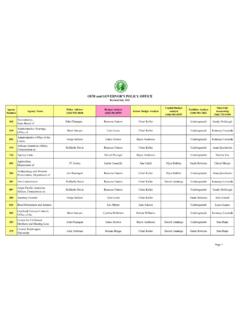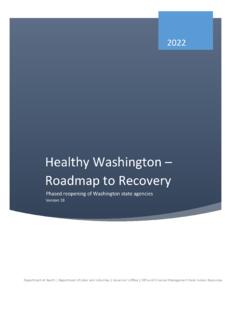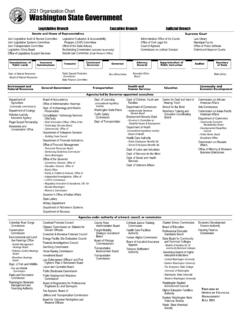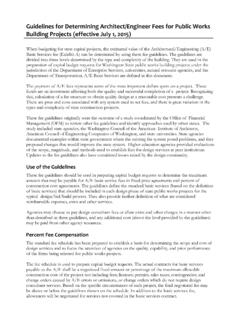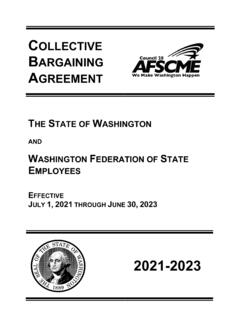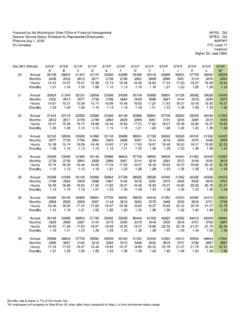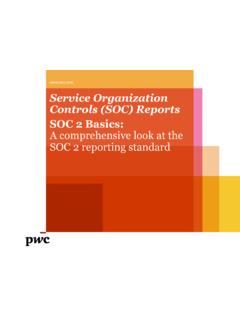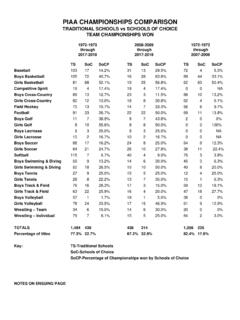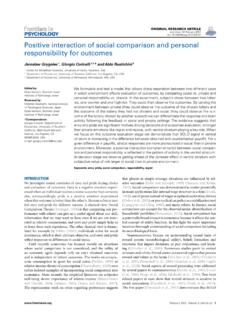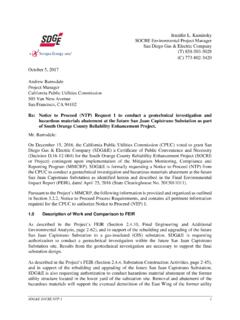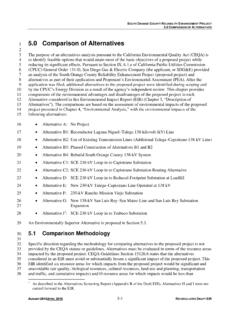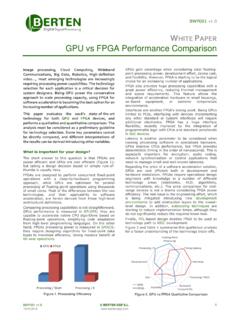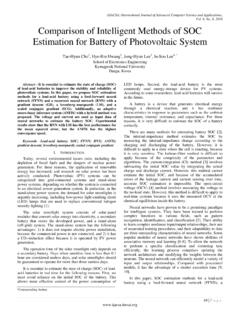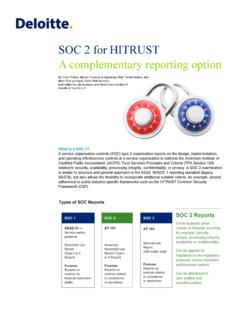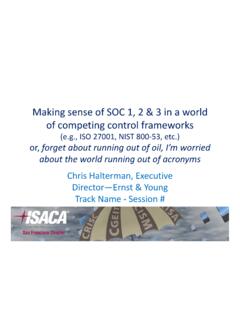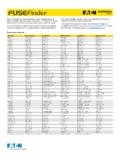Transcription of Understanding How to Leverage SOC Audits - FMAC 06-28-18
1 Understanding How to Leverage SOC AuditsFinancial Advisory Council for the State of WashingtonJune 28, 2018 PresentersChris Kradjan, Partner, CPA, CITP, CRISC, HITRUST CCSFPC hris has over 10 years of experience in the field of SOC, and oversees the IT Compliance Practice and is the National SOC Practice Leader for Moss Adams, including providing quality control for both SOC audit services and technology Audits . Engagements include soc 1 , SOC 2, SOC 2+, SOC 3, and SOC for Cybersecurity. In addition to SOC auditing, Chris s practice areas include cybersecurity Audits , PCI DSS services, HITRUST Audits , security and privacy Audits , internal controls reviews, Sarbanes-Oxley compliance services, and independent technology assessments. Chris is also regularly involved with technology and financial controls assessments based on the NIST, ISO 27002, CSA, ITIL, COBIT and COSO frameworks.
2 Chris recently served on the AICPA Assurance Services Executive Committee (AICPA ASEC), continues to be a member of the AICPA ASEC Trust/Information Integrity Task Force and the AICPA soc 1 and SOC 2 Task Forces, and is working to review the current SOC guides and update the Trust Services Criteria. He has a Bachelor of Arts, Business Administration from Western Washington University2 SOC Overview Type of SOC Reports soc 1 SOC 2 SOC 3 SOC Report Comparison Reviewing SOC Reports Latest SOC Updates Question & AnswersAgenda3 SOC Overview4 Service Organization Control (SOC) reports are internal control reports on the services provided by a service organization Used to assess and address the risks associated with an outsourced service Outsourced services can include any function of a business that is not performed in-house, such as payroll, cloud providers, infrastructure as a service, is a SOC Report5 Companies are increasingly outsourcing aspects of their business to service organizations While outsourcing can increase efficiency and reduce costs, it increases the overall risk the organization faces by no longer having complete control over a process These risks can impact financial statements, operations.
3 And internal controlsRisk of Outsourcing Processes6 Provides an independent examination of the internal controls at the service organization Reduces the cost and administrative burden of multiple Audits over the same process Identifies potential opportunities to strengthen the business practices and operating environment Allows service organizations to communicate information about the company and their control environmentBenefits of a SOC Audit7 Types of SOC Reports8 Overview9 Historical with SAS 70 SAS 70 ReportingNew with SSAE 18 (Replaces SSAE 16) soc 1 Internal Controls Over Financial ReportingNew with AT101 SOC 2 Trust Services Principles (Detailed Reporting) SOC 3 Trust Services Principles (Summary Reporting)SOC Comparison10 Source: AICPASOC 11. Auditor s report2. Management s assertion3. Detail system description and Management controls4.
4 Auditor test of controls and results of those tests control objectivesSOC 21. Auditor s report2. Management s assertion3. Detail system description and Management controls4. Auditor test of controls and results of those tests criteriaSOC 31. Auditor s report2. Management s assertion3. Detailsystem description and Management controls4. Auditor test of controls and results of those tests Type 1 Report Design and implementation of internal controls Point in time As of date Type 2 Report Operating effectiveness of internal controls Period of time Often 12-month periodSOC Type 1 vs. SOC Type 211 SOC 112 Subject matter focuses on internal controlsover financial reporting Auditor-to-auditor communication Restricted use and distribution of report Auditor s of the user-entity s financial statements Management of the user entities Management of the service organization Type 1 or Type 2 report Testing methods Inquiry, observation, inspection, and reperformance Carve-out and inclusive methods Complementary user-entity controlsSOC 113 SOC 2 / SOC 2+14 Subject matter focuses on internal controls related to Trust Services Criteria: Security (Required) Availability (Optional) Processing Integrity (Optional) Confidentiality (Optional) Privacy (Optional) Users of the report include.
5 Stakeholders ( , customers, regulators, business partners, suppliers, directors) of the service organization that have a thorough Understanding of the service organization and its internal controls Restricted use, but intended for a broader range of users, including existing users, prospective users, and regulatorsSOC 215 Well suited for IT and cloud providers SaaS / IaaS / PaaS Application service provider Data centers Virtualized environments Type 1 or Type 2 reports Report presentation similar to soc 1 audit Expected to have limited carve outs and complementary user-entity controlsSOC 216 Infrastructureis comprising the physical structures, IT, and other hardware (facilities, computers, equipment, mobile devices and telecommunications networks) Softwareis the application programs and IT system software that supports application programs (operating systems, middleware, and utilities) Peopleare the personnel involved in the governance, operation and use of a system (developers, operators, entity users, vendor personnel, and managers)
6 Proceduresis the automated and manual procedures Datais the transaction streams, files, databases, and tables and output used or processed by a systemSOC 2 System Boundary Components17 Trust Services Criteria updated in 2016 and again 2017 Security criteria organized into seven common criteria and management and design and implementation of of and physical access management New 2017 update on the horizon around mapping criteria to the COSO frameworkSOC 2 Trust Services Criteria1819 SecurityAvailabilityConfidentialityProce ssing IntegrityPrivacy IT security policy Security awareness and communication Logical access Physical access Environmental controls Security monitoring User authentication Incident management Asset classification / management Systems development and maintenance Personnel security Configuration management Change management Monitoring / compliance Availability policy Backup and
7 Restoration Incident management Disaster recovery Business continuity management Security Change management Monitoring / compliance Confidentiality policy Confidentiality of inputs Confidentiality of data processing Confidentiality of outputs Information disclosures (including third parties) Confidentiality of Information in systems development Incident management Security Change management Monitoring / compliance System processing integrity policies Completeness, accuracy, timeliness, and authorization of inputs, system processing, and outputs Information tracing from source to disposition Incident management Security Change management Availability Monitoring Privacy policies PII classification Risk assessment Incident & breach management Provision of notice Choice and consent Collection Use and retention Disposal Access Disclosure to third parties Security for privacy Quality Monitoring and enforcementSOC 2+ (SOC 2 Plus)
8 20 Used to address criteria in addition to the applicable trust services criteria or additional subject matter related to the service organization s servicesAdditional subject matter can include:1. HIPAA2. HITRUST3. ISO 270014. Cloud Security AllianceExisting SOC 2 controls are mapped to additional criteria or regulations and included in Section 5 SOC 321 Designed for users who want assurance on the controls at a service organization but do not have the need for or the knowledge necessary to make effective use of a SOC 2 report Can be issued concurrently with SOC 2 or separately ( , anytime after issuance of SOC 2) General use report Difference between SOC 2 and SOC 3 layout: Abbreviated system description (section 3) Excludes section 4 (tests of controls and results of tests)SOC 322 SOC Report Comparison23 Internal Controls Over Financial ReportingOperational ControlsSOC 1 SOC 2 SOC 3 Summary Detailed reports for users and auditors Detailed report for users, auditors and specified parties Summary report that can be more generally distributedApplicability Focused on financial reporting risks and controls specified by the service provider Most applicable when the service provider performs financial transactions processing or supports transaction processing systems Focused on the Trust Services Principles.
9 OSecurityoAvailabilityoConfidentialityoP rocessing IntegrityoPrivacy Applicable to a broad variety of systems SOC Comparison Reporting Options24 soc 1 SOC 2/SOC 3 Required Focus Internal control over financial reporting Operational controlsDefine Scope and Systems Classes of transactions Procedures for processing and reporting transactions Accounting records of the systems Handling of significant events and conditions other than transactions Report preparation for users Other aspects relevant to processing and reporting user transactions Infrastructure Software Procedures People DataControl Domains Covered Transaction processing controls Supporting information technology general controls Security Availability Confidentiality Processing Integrity PrivacyLevel of Standardization Control objectives are defined by the service provider and may vary depending on the type of service provided.
10 Principles are selected by the service provider Specific predefined criteria are used rather than control objectivesSOC Comparison Scope25 soc 1 SOC2 SOC 3 Auditor s Opinion Auditor s Opinion Auditor s Opinion Management Assertion Management Assertion Management Assertion Assertion System Description (including Controls) Assertion System Description (including Controls) Assertion System Description (Summary) Control Objectives Criteria Criteria (Referenced) Control Activities Control Activities Test of Operating Effectiveness* Test of Operating Effectiveness* Results of Tests* Results of Tests* Other Information (if applicable) Other Information (if applicable) SOC Comparison Report Structure26*Note: Only applicable for Type 2 1 Type 2 SOC Reports soc 1 SOC 2 soc 1 SOC 2 Coverage Point in time Period of timeAssessment Design Design Operating Effectiveness Results of TestsSOC Comparison Report Types27 Reviewing SOC Reports28 Reliance on service organizations was not identified or not properly documented.
